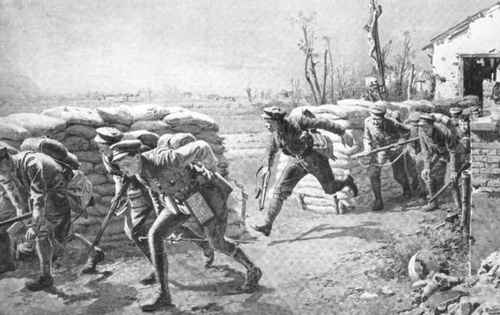Auction: 17003 - Orders, Decorations and Medals
Lot: 696
'A morass which although only some 25 yards wide required an hour to traverse, for we went up to our armpits in the frightful mud … there was nowhere to put down a rifle and keep it dry, every rifle had to be held the whole 48-hour tour. Sleep was impossible; the men simply stood motionless in water for two days and nights … '
Life in the 1st Leinsters at St. Eloi in early 1915; The History of the Prince of Wales's Leinster Regiment, by Colonel F. E. Whitton, C.M.G., refers.
An exceptional and regimentally unique 1914 operations D.C.M. and 'St. Eloi 1915' Dated Bar group of five awarded to Sergeant J. Maher, Leinster Regiment, who died of wounds during the battle of Frezenberg Ridge in May 1915
Distinguished Conduct Medal, G.V.R., with Second Award Bar dated '15th March 1915' (7622 L. Cpl. J. Maher. 2/Leins. Regt.); 1914 Star, with clasp, neatly erased naming and re-gilded; British War and Victory Medals (7622 Cpl. J. Maher, Leins. R.); Russia, Imperial, Cross of the Order of St. George, Fourth Class, silver, reverse officially numbered '127346', generally very fine or better (5)
D.C.M. London Gazette 1 April 1915:
'For gallant conduct at Prémesques on 20 October 1914, in carrying messages on numerous occasions under heavy fire. Was previously brought to notice for gallantry on 23 September at Cour de Soupir, when he brought up food to the trenches whilst exposed to heavy shell fire.'
Bar to D.C.M. London Gazette 3 June 1915:
'For conspicuous gallantry, marked ability, and coolness, at St. Eloi on 15 March 1915, when he took command of the trench after his officer had been killed and repulsed the attack of a very superior force, inflicting great losses on the enemy.'
Russia, Cross of the Order of St. George, 4th Class London Gazette 25 August 1915:
'For gallantry and distinguished service in the field.'
John Maher, who was born at Callan, County Kilkenny, Ireland arrived in France as a Corporal in the 2nd Battalion, Leinster Regiment on 12 September 1914.
D.C.M.
As part of 17th Infantry Brigade, the Battalion was immediately ordered to the Aisne, where, on the night of 21-22 September, it relieved the 2nd Oxfordshire & Buckinghamshire Regiment in front line trenches. The trenches were just in front of a large farm called La Cour-de-Soupir and, according to 2nd Leinsters' war diary, there were large numbers of dead all around. It was on the following day that Maher first came to notice for his gallantry under heavy shell fire, his battalion suffering 40 casualties.
Following 17th Brigade's attack on Bailleul Ridge in mid-October, in which Maher and his comrades were held in reserve, 2nd Leinsters went into action at Prémesques on the 18th. The History of the Prince of Wales's Leinster Regiment, by Colonel F. E. Whitton, states:
'At about 7.30 the Battalion advanced to the attack and soon casualties were experienced, the enemy snipers as usual concentrating on the officers … Enemy rifle and machine-gun fire were now being employed, though in varying intensity all along the front; and, as the advanced progressed, fire came from behind, this being from German snipers who had remained hidden in haystacks and trees.'
The attack cost the 2nd Leinsters 102 casualties.
The enemy counter-attacked on the 20th and 'C' Company was overrun and fell back. 'D' Company also suffered heavily. It was on this date that Maher displayed further gallantry in 'carrying messages on numerous occasions under heavy fire'. Such was the rapidity with which the sound of the discharge of enemy artillery was followed by the explosion of shells that it 'led one to believe the German guns must be firing at point blank' (ibid). That telling barrage was followed by a massed infantry attack, fronted by the 179th Saxon Infantry, the force and scale of which could not be stopped.
Subsequent enemy attacks on the 22nd-23rd were beaten off and, by the time 2nd Leinsters were finally relieved, casualties since the 18th had climbed to 434 officers and men, 155 of them killed.
Maher was awarded the D.C.M. and subsequently transferred to the 1st Battalion. The date of his transfer remains unknown but it is worth noting that the 2nd Leinsters were participants in the famous 'Christmas Truce' of 1914. Some of the Germans they met in No Man's Land had worked in London before the war, one at Selfridges and another in the music halls.
Dated Bar
Maher was back in action with the 1st Battalion at St. Eloi in early 1915, when it took up positions near the "Mound". An artificial heap of earth about thirty feet high, and perhaps half an acre in extent, the mound was situated on the western side of the knoll south of the village. Conditions were abysmal:
'A morass which although only some 25 yards wide required an hour to traverse, for we went up to our armpits in the frightful mud … there was nowhere to put down a rifle and keep it dry, every rifle had to be held the whole 48-hour tour. Sleep was impossible; the men simply stood motionless in water for two days and nights' (ibid).
The nightmare 48-hour tours of duty continued throughout February, the Germans gaining temporary entry to the Battalion's trenches on the 14th: a bitter - and costly - hand-to-hand fight ensued.
A month later - on 15 March 1915 - the enemy returned in force, firing two mines and capturing St. Eloi and the "Mound". Maher was once more conspicuous in action, taking command of a trench after his officer had been killed and repulsing the attack of a superior force:
'At about 4 a.m. on the 15th another battalion which was brought up made a direct attack on the Mound, but it was not successful. During the remaining hours of darkness heavy bursts of machine-gun and rifle fire were directed from the enemy's trenches and as day broke about 5.30 a.m. the Germans made a violent attempt with about one company to capture Trench 22, which was held by Captain Herbert Radcliff, who had only joined us a day or two earlier. The enemy succeeded in practically getting round the right flank and Captain Radcliff was killed, but a very able second took charge in Sergeant Maher (one who had done well in 'A' Company in the 2nd Leinsters earlier) and the enemy was finally beaten off, leaving 34 dead before the trench' (ibid).
He was awarded a Bar to his D.C.M.
Hill 60 - Ypres
Early in April 1915, the 1st Leinsters were deployed to the Hill 60 sector near Ypres:
'Hill 60 was of great tactical importance as it completely covered the line of communication through Sanctuary Wood, and its possession had been hotly disputed during the previous autumn as the number of French, British and German dead testified. In some cases these were inextricably mixed; in other places complete sections appeared to have fallen as if on parade, so accurately were intervals maintained even in death. The trenches were fairly dry due chiefly to the fact that the system had been to build up rather than dig down; but comfort was purchased at the expense of safety for the parapet was by no means bullet proof, and we were soon forced to burrow for more cover. The work was gruesome for a layer of corpses was soon reached. If a body was found to be badly decomposed it was removed piece by piece and these were carried away in sacks for interment. The stench during this ghastly operation was well nigh unbearable and it was not until buckets of chloride of lime had been swilled over the bottom of the trenches that they were fit for occupation' (ibid).
Following their second tour of duty in these trenches, 1st Leinsters were brought to Ypres for a rest. Unfortunately, their period of rest coincided with the enemy bombarding the town with intense vigour. On 19 April two 8-inch shells landed in their billets:
'In several cases the wounded were pinned beneath fallen masonry, but worse was that flames burst out and there was a dread possibility that some of the victims might be roasted alive. Willing hands worked frantically in spite of the German shells which were still falling in the neighbourhood, and after several hours desperate toil all the wounded were extricated and removed to the casualty clearing station' (ibid).
The bombardment continued:
'The civil population suffered terribly and there was frequently witnessed the harrowing spectacle of bleeding women and children rushing through the streets in an agony of terror. The troops gave up their field dressings to bind the wounds of these unfortunate creatures; many now fled Ypres but some of the hardier still remained, and soon the corpse of a civilian in the streets of Ypres became as familiar as the dead body of a soldier in No Man's Land.'
Their unhappy sojourn at Ypres over, the Battalion undertook another tour of duty in the Hill 60 sector. It was hellish:
'Here it became terrible day and night. Fighting bombs, hand grenades, gasses, guns, and rifle fire, flash lights, star shells, just like Crystal Palace. They [the Germans] kept this up for four days and nights … ' (ibid).
Journey's end - Frazenberg Ridge
In early May 1915, 1st Leinsters worked frantically on the construction of a new line of defence - 'running north of St. Jean, north-east of Wieltje, by Franzenberg, east of Hooge, through the woods south of the Ypres-Menin road to join the original line north of Hill 60 … the withdrawal to the new line seems to have taken place during the night of 2-3 May, the old line being destroyed as far as possible and in some cases being blown in by the rear party' (ibid).
On the 5th, Maher and his comrades faced another gas attack:
'Fortunately the wind was blowing diagonal to the front of the Battalion and the effect of the gas was somewhat reduced. By this time the authorities had been able to issue a partial protection in the shape of a small pad soaked in chemicals and worn over the month, but it was soon found that, as no protection was given to the nostrils, and as the men could not remember to breathe solely through the mouth, many were knocked over.'
Whether Maher fell victim to this gas attack, or was wounded when his battalion went to the assistance of the Gloucestershire Regiment on the 7th, remains unknown. Either way, he died of wounds on the 9th.
He has no known grave and is commemorated on the Ypres (Menin Gate) Memorial; sold with copied research.
Reference sources:
Westlake, Ray, British Battalions in France and Belgium 1914 (Leo Cooper, London, 1997).
Whitton, Colonel Frederick Ernest, C.M.G., The History of the Prince of Wales's Leinster Regiment (Gale & Polden, Aldershot).
Subject to 20% VAT on Buyer’s Premium. For more information please view Terms and Conditions for Buyers.
Estimate
£5,500 to £6,500







